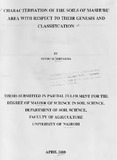| dc.description.abstract | Soils are a component of the ecosystem vital for the maintenance of the land-based life-support
systems and hence, reliable soil information is essential in planning for sustainable development and
environmental conservation. Nevertheless, reliable soil information required for development
planning is scarce. A semi- detailed soil survey of an area in Mashuru division, Kajiado district was
conducted with the principal objective of mapping and characterizing the soils. Specifically, the
morphology, mineralogy, physical and chemical properties of the soils were studied. The soils were
classified according to FAOIUNESCO (1994) and SOIL SURVEY STAFF (1992) versions. The
survey provides information on the area's major soil types and their distribution. A physiographic
soil map at scale 1:50,000 is presented while interpretative soil information is presented in Tables.
The soils mapped in the area include Ferralsols, Vertisols, Cambisols, Leptosols, Acrisols,
Luvisols and Lixisols. Ferralsols are found on uplands and erosional plains. Shallow Leptosols
occur on the hills and scarps while brownish sandy clay to clay Acrisols occur on the
footslopes. Luvisols are found on uplands and on volcanic plains while Lixisols are found on
erosional plains. The saline-sodie Vertisols are found in the bottomlands whereas Cambisols
occur on the piedmont plains and volcanic plains. Based on parent material, relief, climate and
soil characteristics, four genetical groups of soils have been identified in the area. The
Vertisols with high sodium contents and unique physical properties constitute the first group.
Ferralsols and Cambisols with an irregular clay distribution in the profile form the second
group. The Acrisols, Luvisols and Lixisols constitute the third group because of the higher clay
contents in the subsoils. The last group consists of the shallow Leptosols. These soils are
developed on various volcanic rocks and basement system rocks and occur in agro-climatie
zone
The soil forming factors of parent material (geology), climate (past and present) and relief have
played a significant role in the morphology, chemical and physical properties of the soils of the
area. | en |

